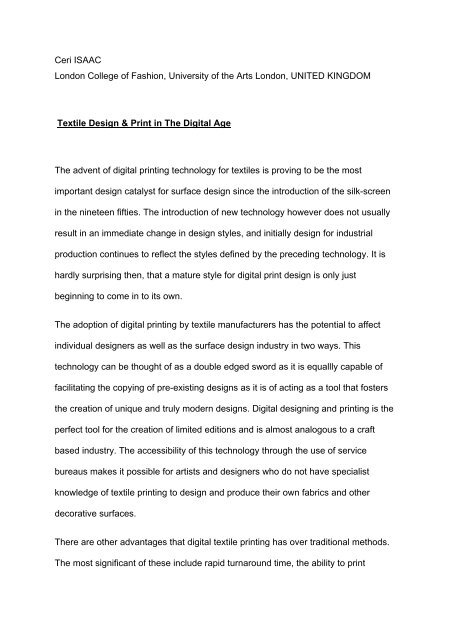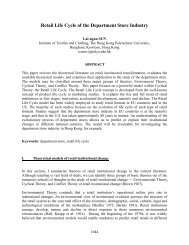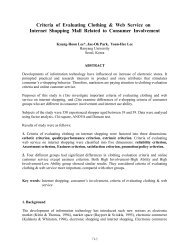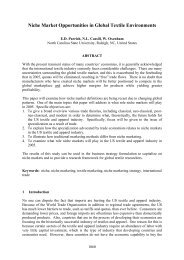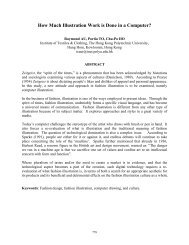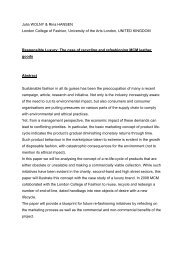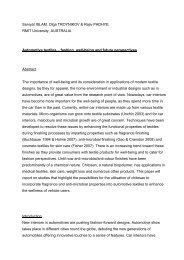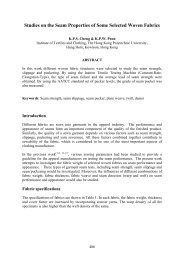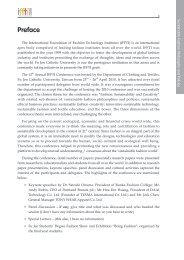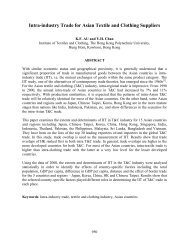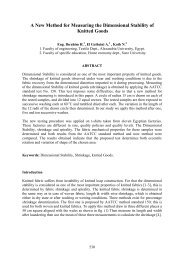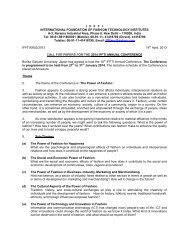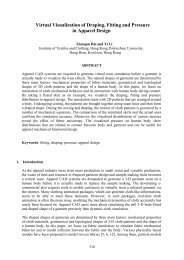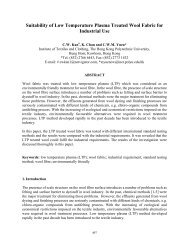Textile Design & Print in The Digital Age - International Foundation ...
Textile Design & Print in The Digital Age - International Foundation ...
Textile Design & Print in The Digital Age - International Foundation ...
Create successful ePaper yourself
Turn your PDF publications into a flip-book with our unique Google optimized e-Paper software.
Ceri ISAAC<br />
London College of Fashion, University of the Arts London, UNITED KINGDOM<br />
<strong>Textile</strong> <strong>Design</strong> & <strong>Pr<strong>in</strong>t</strong> <strong>in</strong> <strong>The</strong> <strong>Digital</strong> <strong>Age</strong><br />
<strong>The</strong> advent of digital pr<strong>in</strong>t<strong>in</strong>g technology for textiles is prov<strong>in</strong>g to be the most<br />
important design catalyst for surface design s<strong>in</strong>ce the <strong>in</strong>troduction of the silk-screen<br />
<strong>in</strong> the n<strong>in</strong>eteen fifties. <strong>The</strong> <strong>in</strong>troduction of new technology however does not usually<br />
result <strong>in</strong> an immediate change <strong>in</strong> design styles, and <strong>in</strong>itially design for <strong>in</strong>dustrial<br />
production cont<strong>in</strong>ues to reflect the styles def<strong>in</strong>ed by the preced<strong>in</strong>g technology. It is<br />
hardly surpris<strong>in</strong>g then, that a mature style for digital pr<strong>in</strong>t design is only just<br />
beg<strong>in</strong>n<strong>in</strong>g to come <strong>in</strong> to its own.<br />
<strong>The</strong> adoption of digital pr<strong>in</strong>t<strong>in</strong>g by textile manufacturers has the potential to affect<br />
<strong>in</strong>dividual designers as well as the surface design <strong>in</strong>dustry <strong>in</strong> two ways. This<br />
technology can be thought of as a double edged sword as it is equallly capable of<br />
facilitat<strong>in</strong>g the copy<strong>in</strong>g of pre-exist<strong>in</strong>g designs as it is of act<strong>in</strong>g as a tool that fosters<br />
the creation of unique and truly modern designs. <strong>Digital</strong> design<strong>in</strong>g and pr<strong>in</strong>t<strong>in</strong>g is the<br />
perfect tool for the creation of limited editions and is almost analogous to a craft<br />
based <strong>in</strong>dustry. <strong>The</strong> accessibility of this technology through the use of service<br />
bureaus makes it possible for artists and designers who do not have specialist<br />
knowledge of textile pr<strong>in</strong>t<strong>in</strong>g to design and produce their own fabrics and other<br />
decorative surfaces.<br />
<strong>The</strong>re are other advantages that digital textile pr<strong>in</strong>t<strong>in</strong>g has over traditional methods.<br />
<strong>The</strong> most significant of these <strong>in</strong>clude rapid turnaround time, the ability to pr<strong>in</strong>t
millions of colours at a high level of detail as well as extreme tonal effects, the<br />
capability to pr<strong>in</strong>t images on a much larger scale and f<strong>in</strong>ally a reduced impact on the<br />
environment. Inkjet pr<strong>in</strong>t<strong>in</strong>g on textiles consumes significantly less dye, water and<br />
energy than the rotary screen-pr<strong>in</strong>t<strong>in</strong>g process does.<br />
Historical Context and Technological Parameters<br />
In order to place the new styles that are emerg<strong>in</strong>g with<strong>in</strong> a historical context, and to<br />
expla<strong>in</strong> the ways <strong>in</strong> which they differ from the earlier styles that were the product of<br />
traditional pr<strong>in</strong>t<strong>in</strong>g methods, a summary will be given of the technology beh<strong>in</strong>d<br />
analogue pr<strong>in</strong>t<strong>in</strong>g. Most traditional methods of textile pr<strong>in</strong>t<strong>in</strong>g are based on<br />
processes that are similar to stencil<strong>in</strong>g techniques. Broadly categorized these<br />
<strong>in</strong>clude the silkscreen, wood block and gravure methods of transferr<strong>in</strong>g artwork on to<br />
fabric. All these processes are restricted to the number of colours it is practical to<br />
pr<strong>in</strong>t and often several days may be required to prepare the “templates”. A separate<br />
template must be created for each colour and the image is then built up <strong>in</strong> stages, as<br />
each colour must be laid down separately. <strong>The</strong> more colours, the more expensive<br />
and time-consum<strong>in</strong>g the process will be so that the number of colours is limited by<br />
what is practical, and <strong>in</strong> some cases places significant restra<strong>in</strong>ts upon the designer.<br />
<strong>The</strong> most common method used today <strong>in</strong> the <strong>in</strong>dustrialized mass production of<br />
pr<strong>in</strong>ted textiles is rotary screen-pr<strong>in</strong>t<strong>in</strong>g. Silk-screen pr<strong>in</strong>t<strong>in</strong>g, as we know it was<br />
patented <strong>in</strong> 1907. <strong>The</strong> pr<strong>in</strong>ciple beh<strong>in</strong>d the silk screen <strong>in</strong>volves the use of a f<strong>in</strong>e<br />
porous mesh that is either stretched over a rectangular frame or built <strong>in</strong>to the form of<br />
a cyl<strong>in</strong>der. <strong>The</strong> design is then del<strong>in</strong>eated by a mask, which leaves open areas for<br />
each colour through which the <strong>in</strong>k is pushed by means of a squeegee.
<strong>The</strong> use of digital pr<strong>in</strong>t is still relatively new to the textile <strong>in</strong>dustry, with the first viable<br />
short run <strong>in</strong>kjet textile pr<strong>in</strong>ters such as the Mimaki TX2 becom<strong>in</strong>g available for<br />
general use <strong>in</strong> 1998. <strong>The</strong> next highly significant step <strong>in</strong> <strong>in</strong>kjet technology, was the<br />
release <strong>in</strong> 2003 of the first <strong>in</strong>dustrial scale <strong>in</strong>kjet pr<strong>in</strong>ters capable of mass production.<br />
Amongst these systems are the Italian developed DReAM by Reggiani and<br />
Robustelli’s Monna Lisa. Ich<strong>in</strong>ose have also developed the Artistri pr<strong>in</strong>ter, which is<br />
capable of longer run production. However currently less than 1% of the world’s<br />
textiles are digitally pr<strong>in</strong>ted as the technology is only really cost effective at the highend<br />
of the fashion and textile design markets, as we will see from the range of<br />
examples discussed <strong>in</strong> this paper. This is due to the elevated cost and limited<br />
production capabilities of digital technology as opposed to analogue methods of<br />
production. Rotary screen pr<strong>in</strong>t<strong>in</strong>g factories are able to pr<strong>in</strong>t up to 55 l<strong>in</strong>ear meters<br />
per m<strong>in</strong>ute at a cost of less than 1 Euro per meter which gives rotary screen pr<strong>in</strong>t<strong>in</strong>g<br />
the advantage. At the time of writ<strong>in</strong>g the <strong>in</strong>dustry standard for the speed of mass<br />
production digital textile pr<strong>in</strong>ters reaches only 4 l<strong>in</strong>ear meters per meter. In the UK<br />
runs of less than 10 meters costs at least £30 per l<strong>in</strong>ear meter. However the newly<br />
developed ISIS digital textile pr<strong>in</strong>ter by Osiris looks to be capable of rival<strong>in</strong>g<br />
traditional pr<strong>in</strong>t<strong>in</strong>g methods as it runs at 30 l<strong>in</strong>ear meters per m<strong>in</strong>ute although the<br />
image quality is not as detailed as other production pr<strong>in</strong>ters.<br />
Comparative Advantages and Disadvantages.<br />
To a certa<strong>in</strong> extent it is <strong>in</strong>evitable that technology dictates style. <strong>The</strong> most significant<br />
disadvantage of traditional textile pr<strong>in</strong>t<strong>in</strong>g methods is the limit of colours it is practical<br />
to pr<strong>in</strong>t as well as the scale of an image. <strong>The</strong> galvano method of engrav<strong>in</strong>g and the
use of photochemical processes as a technique for expos<strong>in</strong>g a template onto a silkscreen<br />
that has been coated with a light sensitive emulsion <strong>in</strong>creased the range of<br />
effects that could be reproduced accurately us<strong>in</strong>g traditional technology. However<br />
the majority of pr<strong>in</strong>t designs found on the high street have been rendered <strong>in</strong> such a<br />
way that either much of the <strong>in</strong>tegrity of the orig<strong>in</strong>al artwork is lost <strong>in</strong> the process of<br />
translation necessitated by analogue technology or designs are simplified <strong>in</strong> order to<br />
accommodate the technology.<br />
<strong>Digital</strong> pr<strong>in</strong>t<strong>in</strong>g has not only brought a whole new range of design imagery and style<br />
with<strong>in</strong> the orbit of the textile designer, it has also brought the ability to pr<strong>in</strong>t an image<br />
on a much larger scale. In traditional pr<strong>in</strong>t<strong>in</strong>g techniques the template for a repeat<strong>in</strong>g<br />
pattern was restricted either by the size of the pattern block or by the size of the<br />
screen or circumference of the roller. By discard<strong>in</strong>g the screen, digital pr<strong>in</strong>t has<br />
changed the whole premise of textile design and the decision to use a repeat<strong>in</strong>g<br />
pattern may now be based upon a conscious desire to create a flow<strong>in</strong>g visual rhythm<br />
that is pleas<strong>in</strong>g and restful to the eye.<br />
Traditional methods of textile pr<strong>in</strong>t<strong>in</strong>g have however produced an irreplaceable<br />
wealth of beautiful fabrics and should <strong>in</strong> no way be considered <strong>in</strong>ferior to designs<br />
that have been created digitally. <strong>The</strong> evolution of technology is <strong>in</strong>evitable and<br />
computer aided design should be seen as simply another tool available to artists and<br />
designers. It is also to be hoped that the hand techniques used <strong>in</strong> the decoration of<br />
cloth will never be entirely replaced but used alongside digital methods. Creativity<br />
will always transcend the limitations of any method where technique is secondary to<br />
the achievement of a designer’s vision.
As the first <strong>in</strong>kjet pr<strong>in</strong>ters capable of pr<strong>in</strong>t<strong>in</strong>g on fabric were only capable of<br />
produc<strong>in</strong>g short runs their primary use was to generate exact reproductions of goods<br />
that were dest<strong>in</strong>ed to be pr<strong>in</strong>ted us<strong>in</strong>g traditional pr<strong>in</strong>t<strong>in</strong>g methods. At this po<strong>in</strong>t <strong>in</strong> the<br />
design cycle very little creativity was <strong>in</strong>volved and the pr<strong>in</strong>ter essentially served as a<br />
k<strong>in</strong>d of glorified albeit sophisticated copy<strong>in</strong>g mach<strong>in</strong>e. Such samples were however<br />
valuable <strong>in</strong> facilitat<strong>in</strong>g pr<strong>in</strong>t on demand so decreas<strong>in</strong>g the need to stock pile goods as<br />
well as shorten<strong>in</strong>g the time needed to test a design idea and the realization of a f<strong>in</strong>al<br />
product.<br />
Photography as Catalyst<br />
One of the most important changes <strong>in</strong> style for modern textile design is the<br />
<strong>in</strong>troduction of photography as medium for surface design. Dye sublimation or heat<br />
transfer pr<strong>in</strong>t<strong>in</strong>g which was the first viable method for pr<strong>in</strong>t<strong>in</strong>g full colour photographic<br />
images on to fabric was discovered <strong>in</strong> 1957. However the process only works with<br />
synthetic high polymer content fabrics, such as polyester. As a result of this<br />
<strong>in</strong>novation polyester garments pr<strong>in</strong>ted us<strong>in</strong>g this new technology were the height of<br />
fashion dur<strong>in</strong>g the n<strong>in</strong>eteen sixties and seventies, reflect<strong>in</strong>g the bright multi coloured<br />
aesthetic of the period. Dye sublimation cont<strong>in</strong>ues to be the primary method used <strong>in</strong><br />
the pr<strong>in</strong>t<strong>in</strong>g of swim and sports wear cloth<strong>in</strong>g today.<br />
As software such as Photoshop was not yet available the first designers who began<br />
to experiment with the possibilities of us<strong>in</strong>g photographic imagery on fabric tended to<br />
use a style that was based on photo- montage or collage.<br />
<strong>The</strong> ability to manipulate and transform an image digitally has meant that the<br />
<strong>in</strong>corporation of photography <strong>in</strong> textile design has now become much more<br />
sympathetic to the very nature of cloth as a material. Cloth is essential to our
everyday lives. It comes to life <strong>in</strong> a way that paper does not <strong>in</strong> that it moves and<br />
reflects light. Photographs formatted as for a pr<strong>in</strong>t onto paper can appear as a stark<br />
<strong>in</strong>congruous statement when translated literally on to fabric. <strong>Design</strong><strong>in</strong>g a textile,<br />
ultimately <strong>in</strong>tended as a decorative surface, often <strong>in</strong>volves a very different sensibility<br />
from that <strong>in</strong>herent <strong>in</strong> pure photography. On paper, photographs are often <strong>in</strong>tended as<br />
story-tell<strong>in</strong>g documents whereas the hybrid use of photography <strong>in</strong> textile design has<br />
now begun to create a very different style <strong>in</strong> which the image is subtle or abstracted -<br />
render<strong>in</strong>g it more mysterious.<br />
Ambassadors of elite fashion, Jean Paul Gaultier, Gilles Rosier and Husse<strong>in</strong><br />
Chalayan have used digital photographs as an elegant device for the embellishment<br />
of their creations. Although the pr<strong>in</strong>ts used <strong>in</strong> the garments illustrated below are<br />
subtle and understated <strong>in</strong> terms of colour and imagery they are the focal po<strong>in</strong>t of the<br />
garments and perhaps even their raison d’être. Gaultier has added a level of mystery<br />
to his gown, draw<strong>in</strong>g the viewer’s eye <strong>in</strong>to the textures and patterns <strong>in</strong> a digitally<br />
manipulated photograph of the frayed pages of antique books. <strong>The</strong> same is true of<br />
Chalayan <strong>in</strong> his creation of a pr<strong>in</strong>t which when viewed from a distance, appears as<br />
an abstract texture but upon closer exam<strong>in</strong>ation reveals itself to be an entirely<br />
different motif based on a photograph of broken glass.<br />
Prior to the <strong>in</strong>troduction of digital pr<strong>in</strong>t<strong>in</strong>g it was not possible to translate all the<br />
nuances and details of a photograph or pa<strong>in</strong>t<strong>in</strong>g on to fabric. <strong>The</strong> ability of digital<br />
pr<strong>in</strong>t<strong>in</strong>g to reproduce millions of colours at a higher resolution than traditional pr<strong>in</strong>t<strong>in</strong>g<br />
methods has opened up an almost <strong>in</strong>f<strong>in</strong>ite range of design possibilities to fashion<br />
and textile designers.
Trompe l’oeil is a style that particularly lends itself to digital surface design. Comme<br />
des Garçons and the French designer, Giles Rosier, have used this to full effect<br />
through the conceptualization of a garment and its drap<strong>in</strong>g on the body by pr<strong>in</strong>t<strong>in</strong>g a<br />
full-scale image of a dress upon a dress. <strong>The</strong>se images have been carefully<br />
eng<strong>in</strong>eered from photographs that appear almost as if they have been projected onto<br />
the model. London College of Fashion student Jula Re<strong>in</strong>dell also employs a trick of<br />
the eye through the extreme realism of her humorous and surreal “hair cut “ shirt.<br />
Paul Smith is another pioneer of digital surface design, us<strong>in</strong>g <strong>in</strong>kjet pr<strong>in</strong>ts <strong>in</strong> both his<br />
men’s and women’s wear collections. True to his trademark use of bright yet<br />
sophisticated colour his designs make reference to tradition while also be<strong>in</strong>g very<br />
modern <strong>in</strong> their impact. <strong>The</strong> majority of Smith’s digital textile designs are<br />
photographic <strong>in</strong> style.<br />
Pa<strong>in</strong>t<strong>in</strong>g and <strong>Digital</strong> <strong>Pr<strong>in</strong>t</strong><br />
In the same way that digital pr<strong>in</strong>t<strong>in</strong>g has made it possible to accurately reproduce a<br />
photograph on to fabric it has also meant that all the details and subtleties of a<br />
pa<strong>in</strong>t<strong>in</strong>g or draw<strong>in</strong>g may be captured <strong>in</strong> the f<strong>in</strong>al pr<strong>in</strong>t. Husse<strong>in</strong> Chalayan<br />
demmostrates this with a subtly rendered futuristic pr<strong>in</strong>t for his Spr<strong>in</strong>g Summer 2009<br />
collection. <strong>The</strong> tonality and blend<strong>in</strong>g of the colours found <strong>in</strong> this design, the motifs of<br />
which are somehow suggestive of mach<strong>in</strong>e parts, although possible would be difficult<br />
to capture us<strong>in</strong>g analogue technology. <strong>The</strong> old master-style oil pa<strong>in</strong>t<strong>in</strong>g used <strong>in</strong><br />
Chalayan’s Autumn W<strong>in</strong>ter 2008 collection also illustrates digital pr<strong>in</strong>t<strong>in</strong>g’s ability to<br />
render the subtle nuances of a pa<strong>in</strong>t<strong>in</strong>g as does the water colour style pr<strong>in</strong>t by Etro.
<strong>Digital</strong> Tailor<strong>in</strong>g<br />
<strong>The</strong> fact that digital pr<strong>in</strong>ters are easily able to accommodate large scale designs<br />
coupled with the streaml<strong>in</strong><strong>in</strong>g of other technologies such as body scann<strong>in</strong>g and<br />
automatic pattern generation means that an <strong>in</strong>creas<strong>in</strong>g number of designers are<br />
us<strong>in</strong>g eng<strong>in</strong>eered pr<strong>in</strong>ts as part of their collections. Such <strong>in</strong>tegration of pr<strong>in</strong>t is<br />
becom<strong>in</strong>g as vital to the designer’s vision as the form of the garment or product itself,<br />
due to the immediacy and spontaneity that digital tools afford. Notable designers of<br />
the twentieth century such as Sonia Delaunay, Emilio Pucci and Gianni Versace<br />
favored eng<strong>in</strong>eered screen-pr<strong>in</strong>t<strong>in</strong>g. <strong>The</strong>se designers knew that their garments would<br />
be perceived as be<strong>in</strong>g more luxurious if a placement pr<strong>in</strong>t was employed as such<br />
designs are more costly and time consum<strong>in</strong>g to produce. More recently Tristan<br />
Webber, Jonathan Saunders and Basso & Brooke have employed the technique<br />
us<strong>in</strong>g digital textile pr<strong>in</strong>t<strong>in</strong>g.<br />
<strong>The</strong> pr<strong>in</strong>t used by McQueen’s dress <strong>in</strong> his Spr<strong>in</strong>g Summer 2008 collection was<br />
<strong>in</strong>spired by the feathers of exotic birds and epitomizes the way that the use of digital<br />
tools facilitates tailored pr<strong>in</strong>ts. <strong>The</strong> different colored bands of overlapp<strong>in</strong>g feathers<br />
have been laid out so that they circle the model's waist and then spread out to fit the<br />
skirt as it widens. Such an “eng<strong>in</strong>eered” pr<strong>in</strong>t requires careful plann<strong>in</strong>g and accuracy<br />
<strong>in</strong> its draftsmanship.<br />
To the same end a group of designers, from the Fashion Science Research Hub at<br />
the London College of Fashion collaborated <strong>in</strong> order to explore the ways that state of<br />
the art technology could be used to create a one-of-a-k<strong>in</strong>d garment where the use of<br />
a carefully constructed digital pr<strong>in</strong>t<strong>in</strong>g as a means of embellish<strong>in</strong>g a garment adds to<br />
the perceived level of value and luxury of the piece.
Graphic Styles<br />
<strong>The</strong> cross-discipl<strong>in</strong>ary use of graphics programmes, digital photography, video stills<br />
and special effects by a hybrid generation of young designers is creat<strong>in</strong>g a new look<br />
for pr<strong>in</strong>ted fabrics. As the generation that has come of age <strong>in</strong> the digital era, many<br />
young and emerg<strong>in</strong>g designers have begun to use digital pr<strong>in</strong>ts <strong>in</strong> their collections.<br />
For some it provides a natural foundation <strong>in</strong> the conceptualization of their work,<br />
seamlessly <strong>in</strong>tegrat<strong>in</strong>g their other design skills as graphic and illustrative artists <strong>in</strong>to<br />
the creation of each piece of work.<br />
Husse<strong>in</strong> Chalayan’s name has long been synonymous with technology and his use<br />
of digital pr<strong>in</strong>t goes far beyond the obvious decoration of a garment. His seem<strong>in</strong>gly<br />
effortless use of graphics emphasizes the sculptural form of the garment itself. <strong>The</strong><br />
graphic style of his “robotic” dress is emblematic of surface design <strong>in</strong> the digital age.<br />
London College of Fashion student Georgie Ichikawa also attracted attention through<br />
the bold use of pr<strong>in</strong>ts that were the focal po<strong>in</strong>t of his MA collection.<br />
“<strong>The</strong> Garden of Eden” by Heather Ujiie was exhibited as a large-scale wall hang<strong>in</strong>g<br />
at Moore College of Art, Philadelphia, USA. <strong>The</strong> piece demonstrates Heathers<br />
considerable skills <strong>in</strong> draftsmanship and her elegant graphics are aga<strong>in</strong><br />
representative of the new design styles that are emerg<strong>in</strong>g.<br />
<strong>The</strong> Revival of <strong>The</strong> <strong>Textile</strong> Industry<br />
As the cost of a large format <strong>in</strong>kjet pr<strong>in</strong>ter is considerably less than the equipment<br />
necessary to set up a rotary screen-pr<strong>in</strong>t<strong>in</strong>g plant, many small digital pr<strong>in</strong>t bureaus
are emerg<strong>in</strong>g that specialize <strong>in</strong> the pr<strong>in</strong>t<strong>in</strong>g of textiles. Bureau pr<strong>in</strong>t<strong>in</strong>g services<br />
provide an <strong>in</strong>valuable resource to students, <strong>in</strong>dependent designers and larger<br />
commercial companies alike. <strong>The</strong> potential markets for digital textile pr<strong>in</strong>t<strong>in</strong>g ranges<br />
for example from the fashion <strong>in</strong>dustry, through costume and set design to <strong>in</strong>terior<br />
design and the recreation of antique textiles to be used <strong>in</strong> museum conservation.<br />
Some bureaus operate out of an artist’s loft while others are set up like small<br />
factories with multiple pr<strong>in</strong>ters, cater<strong>in</strong>g to a grow<strong>in</strong>g demand for <strong>in</strong>novative and<br />
unusual products.<br />
<strong>The</strong>se small bus<strong>in</strong>esses will support the grow<strong>in</strong>g demand for designer and bespoke<br />
goods and may result <strong>in</strong> a revival of the textile <strong>in</strong>dustry <strong>in</strong> countries that have lost<br />
their fabric production to Asia. An example of a bureau currently operat<strong>in</strong>g <strong>in</strong> the UK<br />
is Elanbach founded by Sir Bernard Ashley formally of Laura Ashley. Elanbach offer<br />
their own l<strong>in</strong>e of exquisitely coloured home furnish<strong>in</strong>g fabrics as well as a custom<br />
fabric pr<strong>in</strong>t<strong>in</strong>g service for any artwork provided by the client. <strong>The</strong> company’s home<br />
furnish<strong>in</strong>g designs are semi customizable as the client may choose from a range of<br />
coord<strong>in</strong>ated palettes. Pr<strong>in</strong>ce Charles recently commissioned one such design by<br />
Elanbach.<br />
<strong>The</strong>re are at least 13 digital pr<strong>in</strong>t bureaus currently operat<strong>in</strong>g <strong>in</strong> the UK only 2 or 3 of<br />
which are capable of offer<strong>in</strong>g mass production. As the lead-time for complet<strong>in</strong>g an<br />
order is usually 2 weeks this suggests that demand for pr<strong>in</strong>t<strong>in</strong>g exceeds the<br />
comb<strong>in</strong>ed capacity of bureaus <strong>in</strong> the UK. <strong>The</strong> market is wide open and there is room<br />
for growth <strong>in</strong> this area. Heat transfer pr<strong>in</strong>t<strong>in</strong>g aside, banner and signage pr<strong>in</strong>ters tend<br />
to pr<strong>in</strong>t on to synthetic substrates where the end result is not washable and as the<br />
use of PVC is <strong>in</strong>creas<strong>in</strong>gly discouraged due to it’s effect on the environment it would
e advantageous for such bus<strong>in</strong>esses to <strong>in</strong>vest <strong>in</strong> the k<strong>in</strong>d of specialized digital<br />
textile pr<strong>in</strong>t<strong>in</strong>g technology described <strong>in</strong> this paper.<br />
Perceived Value<br />
Perhaps the true worth of digital surface design and pr<strong>in</strong>t <strong>in</strong> a world of throw-away<br />
fashion is <strong>in</strong> the creation of designs that will be kept and treasured by the consumer.<br />
<strong>The</strong> hand of the designer will speak through the uniqueness of each piece. It may be<br />
hoped that aesthetic values will play an <strong>in</strong>creas<strong>in</strong>g role <strong>in</strong> our sense of well be<strong>in</strong>g as<br />
the trend towards considerate design ga<strong>in</strong>s momentum. Shopp<strong>in</strong>g from the high<br />
street ultimately dresses us as clones and the ability of digital pr<strong>in</strong>t<strong>in</strong>g to aid <strong>in</strong> the<br />
creation of limited edition products should aid <strong>in</strong> the celebration of the <strong>in</strong>dividual. <strong>The</strong><br />
images <strong>in</strong>cluded <strong>in</strong> this paper speak for themselves <strong>in</strong> illustrat<strong>in</strong>g the way <strong>in</strong> which<br />
surface designers are currently us<strong>in</strong>g computer-aided design <strong>in</strong> conjunction with<br />
digital pr<strong>in</strong>t<strong>in</strong>g. <strong>The</strong>y are develop<strong>in</strong>g a more mature style <strong>in</strong> which these digital tools<br />
are beg<strong>in</strong>n<strong>in</strong>g to come <strong>in</strong>to their own.


